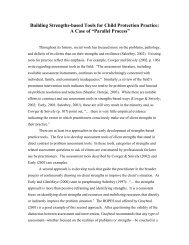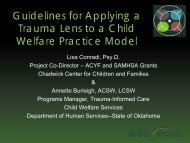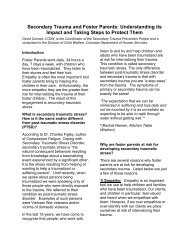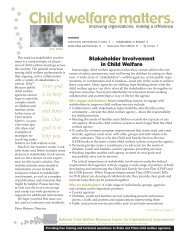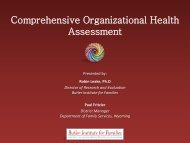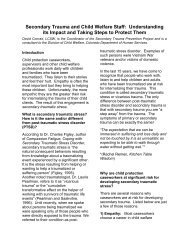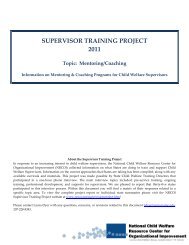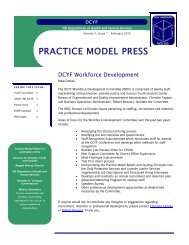Building a Model and Framework for Child Welfare Supervision
Building a Model and Framework for Child Welfare Supervision
Building a Model and Framework for Child Welfare Supervision
You also want an ePaper? Increase the reach of your titles
YUMPU automatically turns print PDFs into web optimized ePapers that Google loves.
Component 2<br />
A model of supervisory practice that reflects how the<br />
organization views the roles, responsibilities, <strong>and</strong><br />
expectations of supervisors <strong>and</strong> includes up-to-date, written<br />
job descriptions.<br />
A serious, but preventable, obstacle to effective child welfare supervision is the lack of a defined<br />
child welfare supervisory practice model that reflects how the field <strong>and</strong> the organization view the<br />
supervisory position, including current, specific job descriptions <strong>for</strong> supervisors. Both the literature<br />
<strong>and</strong> key in<strong>for</strong>mants in the field stress the importance of developing “a coherent model of<br />
supervision, impart[ing] it to staff <strong>and</strong> rigorously<br />
evaluat[ing] its impact” (Sundet et al. 2003; also The description of my responsibilities is very<br />
Collins-Camargo 2006:83). Our in<strong>for</strong>mants<br />
general <strong>and</strong> includes only a few tasks, such as<br />
frequently reported that their organizations lacked<br />
“Provides direct supervision.” – Supervisor<br />
both this critical resource <strong>and</strong> clearly stated<br />
expectations <strong>and</strong> job descriptions <strong>for</strong> agency<br />
supervisors.<br />
Kadushin <strong>and</strong> Harkness (2002) emphasize that ongoing stress in being a supervisor “results from<br />
lack of clear definition of the supervisor’s tasks, responsibilities, <strong>and</strong> authority” (p. 293). A specific,<br />
written description of child welfare supervisors’ responsibilities should be developed (Allnoch<br />
1998; NRCOI 2007; Sundet & Kelly 2007) <strong>and</strong> used to:<br />
• identify the skill set <strong>and</strong> other characteristics sought when We have a generalized job<br />
recruiting <strong>and</strong> hiring/selecting supervisors in order to “get description on the agency<br />
the right people” (Collins 2005);<br />
website, but it is so broad that<br />
• develop a per<strong>for</strong>mance appraisal <strong>for</strong> child welfare<br />
it doesn't address what<br />
supervisors; <strong>and</strong><br />
supervisors do. – Administrator<br />
• assist supervisors in evaluating their own needs <strong>for</strong> training<br />
<strong>and</strong> professional development <strong>and</strong> identifying issues <strong>for</strong><br />
their own supervision.<br />
Without explicit written in<strong>for</strong>mation about supervisors’ role, functions, responsibilities <strong>and</strong><br />
expectations, the agency cannot recruit <strong>and</strong> select appropriate applicants <strong>for</strong> supervisory positions.<br />
As Kadushin <strong>and</strong> Harkness note, “The skills of managing are different from the skills of doing”<br />
(2002: 283). Clarity about responsibilities <strong>and</strong> expectations allows potential applicants <strong>and</strong> those<br />
selecting child welfare supervisory personnel to identify <strong>and</strong> evaluate the fit between a person’s<br />
knowledge, skills, <strong>and</strong> attitudes <strong>and</strong> a specific supervisory position. The written description of a<br />
child welfare supervisor’s role, responsibilities, <strong>and</strong> expectations also helps supervisors identify<br />
their own training <strong>and</strong> supervision needs.<br />
A written job description <strong>for</strong> supervisors<br />
Often the way staff is obtained is sort of like Russian<br />
should focus equally on the three main<br />
roulette, not about matching the needs <strong>and</strong> strengths of<br />
supervisory functions defined by<br />
Kadushin—administrative, educational, the workers with the needs, capability, <strong>and</strong> style of a<br />
<strong>and</strong> supportive supervision. A sample job supervisor. – Supervisor<br />
description is provided in Appendix D.<br />
30




